Abstract
This study systematically investigated the efficacy of ultrasound technology in removing deoxynivalenol (DON, also known as vomitoxin) from contaminated wheat grains and its impact on grain quality. By applying different ultrasonic frequencies (single-frequency 22 kHz, dual-frequency 22/40 kHz, and tri-frequency 22/33/40 kHz) and treatment durations (10–40 min), the removal efficiency of DON and changes in quality characteristics—including moisture content, weight gain, solid loss, color, hardness, and viscosity—were analyzed. Experimental results demonstrated that dual-frequency ultrasound (22/40 kHz) achieved the highest DON removal rate (25.84%) after 40 min, significantly outperforming single- and tri-frequency treatments. Ultrasound treatment increased the moisture content and weight of wheat grains, reduced hardness (though without significant differences), and affected color and viscosity. This study revealed that multi-frequency ultrasound enhances DON removal through synergistic cavitation effects, with dual-frequency ultrasound offering a superior balance between removal efficiency and energy consumption. This research provides a theoretical foundation and technical references for the safe and efficient elimination of DON contamination in wheat.
1. Introduction
DON, also known as vomitoxin, is a trichothecene mycotoxin produced by fungi such as Fusarium graminearum. As one of the most significant fungal contaminants in global food and feed supplies, DON accumulation in grains is closely linked to infections caused by Fusarium Head Blight (FHB) []. FHB not only drastically reduces crop yields but also poses a dual threat to food security and human/animal health through the food chain due to DON bioaccumulation []. Exposure of humans and animals to DON through ingestion of contaminated food can induce acute and chronic effects such as reproductive toxicity, cytotoxicity, enterotoxicity, immunotoxicity, neurotoxicity, etc. []. Animals with acute DON poisoning exhibit symptoms such as nausea, vomiting, diarrhea, and abdominal pain. Chronic toxicity of DON leads to reduced food intake, impaired growth and weight gain, immune system damage, and induction of cellular carcinogenesis [].
The most severe DON contamination among cereals occurs in wheat, and many countries around the world have reported cases of harvested wheat with excessive DON levels [,,,,]. With the growing concern over food safety in recent years, there has been increased global attention to the issue of DON contamination in wheat. To address this issue, researchers have developed various degradation techniques, primarily categorized into physical, chemical, and biological methods []. Physical approaches include adsorption, thermal treatment, high-pressure processing, cold plasma, and irradiation [,,,]; chemical methods involve ozone treatment, alkaline processing, and redox reactions [,,]; biological strategies encompass microbial degradation and enzymatic methods []. However, these techniques face challenges, such as high equipment costs, nutrient loss, operational complexity, and potential secondary hazards. Consequently, there is an urgent demand for novel, safe, and efficient technologies to mitigate DON contamination in wheat intended for food and feed production.
Ultrasound, a mechanical wave with frequencies above 20 kHz, generates physicochemical effects—including cavitation, mechanical shear forces, and free radical reactions—through high-frequency vibrations in liquid or solid media. It has been widely applied in fields such as food processing and environmental remediation [,,]. The mechanism of ultrasonic removal of DON may be attributed to hydroxyl radicals generated by the cavitation effect. These reactive species can degrade DON through oxidative attacks, thereby facilitating its detachment or decomposition. A study reported that ultrasonic treatment with a power intensity of 4.4 W/cm3, a duty cycle of 66.7%, and a duration of 50 min reduced the concentration of DON by 43.2%. In addition, ultrasound, which combines the advantages of easy operation, no introduction of other chemicals in the treatment, and mild and fast reaction conditions, has shown potential in the field of organic matter degradation, such as in wastewater treatment [] and plastics degradation []; however, the use of ultrasonic treatment for DON has rarely been reported. The aim of this study was to investigate the removal effect of ultrasonic treatment on DON in wheat and its effect on wheat quality. The effect of ultrasonic treatment on DON content in wheat was systematically investigated by setting different ultrasonic times and ultrasonic frequencies, and the changes in quality characteristics such as water content, weight gain, solids loss, color, hardness, and viscosity of treated wheat were analyzed.
2. Materials and Methods
All experiments and data collection were conducted between May 2024 and March 2025.
2.1. Ingredients and Toxin Selection
High-quality wheat harvested in 2024 (initial DON content: 2080 ppm; provided by the Taizhou Grain and Oil Quality Monitoring Institute; cultivar: Ningmai 13).
2.2. Instruments and Reagents
Reagents: methanol (analytically pure), pure water.
All experimental apparatus and equipment employed in this study are summarized in Table 1.

Table 1.
Instruments and equipment.
2.3. Experimental Methods
2.3.1. Raw Material Handling
First, remove visible impurities from the raw materials (lighter impurities like wheat ears are eliminated through vibratory screening and air aspiration, while heavier impurities such as stones are removed via sieving with mesh screens, followed by thorough manual inspection and removal). Then, select wheat grains that are uniform in shape, size, and color for subsequent experiments.
2.3.2. Ultrasonic Treatment
Measure 25 mL of purified water into a plastic container, add 25 g of impurity-removed wheat kernels (wheat typically requires conditioning to increase moisture to 15–16% before processing; this experiment used ultrasonic water treatment instead, omitting the conditioning step). Secure the container in the ultrasonic device, ensuring the water level in the ultrasonic chamber exceeds that in the container to maximize ultrasonic exposure of the kernels.
Continuous ultrasound treatment was applied under three frequency modes: single-frequency (22 kHz), synchronized dual-frequency (22/40 kHz), and synchronized tri-frequency (22/33/40 kHz) []. Prior to treatment, the ultrasonic water bath was preheated to 25 °C. The wheat samples were subjected to ultrasound for durations of 10, 20, 30, and 40 min, with continuous stirring using a glass rod to ensure uniform exposure. Throughout the process, the water bath temperature was monitored in real time and maintained at 25 °C via a peristaltic pump. This setup aimed to evaluate the effects of ultrasound parameters on DON removal and grain quality without introducing additional moisture conditioning steps.
2.3.3. Sample Processing
After ultrasound treatment, the samples were filtered through rapid-filter paper into 15 mL centrifuge tubes, labeled appropriately, and stored at 4 °C in a refrigerator.
The filtered wheat grains were then blot-dried with filter paper to remove surface moisture, placed in glass petri dishes, and dried in a 40 °C oven until constant weight was achieved (defined as a mass difference of less than 0.1 g between consecutive 30 min intervals).
2.3.4. DON Detection
The filtered wheat filtrate was prepared into a 15% methanol solution (v/v) and analyzed for DON content using the HMG001 Rapid Detection and Monitoring Analysis System (Type II).
2.3.5. Preservation of Dried Wheat Sample
After drying the wheat grains to constant weight, they were placed in self-sealing bags with as much air expelled as possible before sealing. The bags were labeled appropriately and stored collectively in a desiccator and preserved at 4 °C for subsequent wheat quality analysis.
2.3.6. Measurement of Wheat Quality
(1) Determination of moisture content
The ultrasonically treated wheat kernels were drained of surface water with filter paper, the weight of the sample after water absorption was recorded as , the sample was dried in an oven at 40 °C until constant weight, the last weighed weight was recorded as , and the moisture content was derived and the curve of change of moisture content-treatment conditions was plotted according to the following formula:
where denotes the moisture content (%), and represent the weight of the specimen before and after drying, respectively (g).
(2) Determination of weight gain and solid loss
For each trial, 25 g of wheat grains were subjected to ultrasound treatment. After treatment, the grains were blot-dried to remove surface moisture and then oven-dried to a constant weight. The weight gain and solid loss during ultrasound processing were calculated using the following formulas:
In the formulas, represents weight gain (%), represents solid loss (%), denotes the weight (g) of wheat after ultrasound-mediated DON removal, denotes the initial weight (g) of wheat before ultrasound treatment, and denotes the weight (g) of solid matter lost after ultrasound treatment.
(3) Colorimetry
Color measurement of wheat grain and wheat flour
A4 paper was used as a control, wheat seeds were laid flat in a single layer as well as wheat seeds were ground in a grinder and sieved through an 80-mesh sieve, sieved wheat was laid flat and then measured separately with a HunterLab handheld spectrophotometric colorimeter, three values of , , and were recorded, and, for each condition, three different positions were selected for measurement and recorded.
The color difference is calculated according to the following formula:
In the formula, , , and represent the color readings of the original untreated wheat sample. The ranges for , , and are defined as follows: 0 (black)–100 (white), −60 (green)–60 (red), and 60 (blue)–60 (yellow).
(4) Measurement of Hardness
After drying, the wheat grains were screened, and approximately ten grains of similar size, uniform shape, and consistent color were selected. The hardness of the grains was measured using a TA-XT2i Food Texture Analyzer equipped with a P50 probe. The instrument parameters were set as follows: pre-test speed: 2.0 mm/s; test speed: 1.0 mm/s; post-test speed: 5.0 mm/s; deformation level: 20.0%; deformation force: 5.0 g.
(5) Measurement of viscosity
A total of 2.5 g of wheat flour was thoroughly mixed with 25 mL of distilled water in a 50 mL centrifuge tube. The mixture was shaken in a constant-temperature incubator for 1 h and then centrifuged at 4000 rpm for 20 min. The supernatant was collected as the viscosity test solution. The viscosity of the aqueous wheat flour extract was measured using a Ubbelohde viscometer, and the data were recorded. The kinematic viscosity was calculated according to the formula provided in the GB/T 55516-2011 standard [].
In the formula, v represents the kinematic viscosity of the sample (mm2/s), t is the time(s) for the solution to flow between the upper and lower graduation marks of the viscometer’s timing bulb, and c is the viscometer constant (mm2/s2). The Ubbelohde viscometer used in this experiment has a constant c of 137 mm2/s2.
3. Experimental Results and Analysis
The collected data were averaged from the measurements and processed using Excel software, then subsequently analyzed and graphically visualized with Origin 2018 and SPSS Statistics 27 software.
3.1. Impact of Ultrasound Duration on DON Removal Efficiency in Wheat Grains
As shown in Figure 1 and Table 2, both the control and experimental groups exhibited a gradual increase in DON content in the wheat filtrate under constant ultrasonic treatment at 25 °C. This indicates that, during the treatment process, DON on the surface of wheat grains gradually migrated into the filtrate, resulting in a progressive decrease in DON content within the wheat grains and a corresponding increase in the filtrate. The observed phenomenon may be attributed to ultrasonic cavitation effects: prolonged treatment duration enhances cavitation bubble density, whose subsequent collapse generates localized high-temperature/high-pressure microenvironments and reactive oxygen species (e.g., hydroxyl radicals), thereby facilitating DON removal []. Notably, under 30–40 min sonication across all tested frequencies, the wheat filtrate demonstrated elevated DON concentrations with optimal removal efficacy.
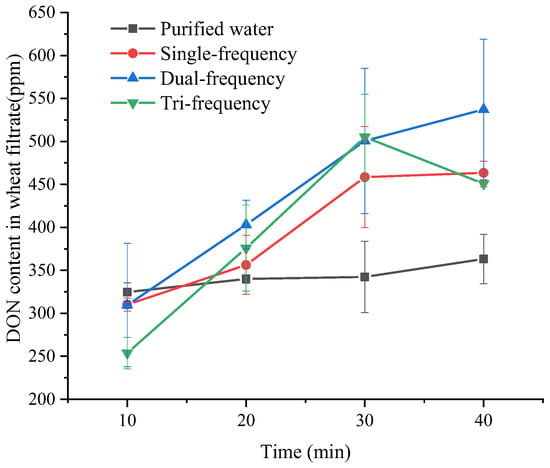
Figure 1.
Effect of different ultrasound conditions on the content of DON in wheat grain filtrate.

Table 2.
Effect of ultrasonic time on DON degradation effect in wheat.
From a mechanistic perspective, the unique cavitation effects of ultrasound are likely the critical factor underlying this phenomenon. When ultrasonic waves propagate through a liquid medium, cavitation bubbles undergo periodic oscillations under acoustic pressure, with their number density increasing progressively with prolonged treatment duration. Upon reaching critical dimensions, these bubbles undergo implosive collapse, generating transient extreme conditions (localized temperatures > 5000 K, pressures > 1000 atm) and highly reactive free radicals (e.g., hydroxyl radicals, OH). Such drastic physicochemical conditions not only disrupt key chemical bonds in DON molecules (e.g., C-O bonds, epoxide groups) but also accelerate oxidative decomposition through radical-mediated chain reactions, thereby achieving efficient toxin degradation [,].
It is noteworthy that, at 30 and 40 min treatment durations, ultrasonic treatments at different frequencies all demonstrated optimal removal efficiency. Moreover, the DON removal rate from wheat kernels in the experimental group was significantly higher at 30 or 40 min than that at 10 min. This time-dependent effect may be associated with the cumulative cavitation bubble dynamics: prolonged treatment duration not only increases the total number of cavitation events but also maintains the activated state of the reaction system through continuous energy input, thereby allowing sufficient reaction opportunities for hard-to-elute toxin molecules.
3.2. Impact of Ultrasound Frequency on DON Removal Efficiency in Wheat Grains
Based on the experimental results from Table 2, the control group (without ultrasound treatment) exhibited DON removal rates of 15.62%, 16.36%, 16.47%, and 17.47% after 10, 20, 30, and 40 min of pure water immersion, respectively. These data indicate that partial physical dissolution and removal of DON from wheat surfaces can occur through water immersion alone, likely mediated by mechanisms such as toxin migration via water penetration, hydration of polar groups, and disruption of surface adsorption structures caused by mechanical friction. Notably, the incremental increase in removal rates slowed over time (only a 1.86% rise from 10 to 40 min), demonstrating the limitations of relying solely on hydraulic action for efficient toxin removal.
Comparative analysis of experimental group data confirmed the enhanced removal efficacy of ultrasound treatment. Under single-frequency ultrasound (22 kHz), DON removal rates increased significantly with prolonged exposure: 14.91% (10 min), 17.14% (20 min), 22.05% (30 min), and 22.29% (40 min). Dual-frequency (22/40 kHz) and tri-frequency (22/33/40 kHz) ultrasound further optimized removal efficiency, achieving rates of 14.88%, 19.39%, 24.08%, and 25.84% (dual-frequency) and 12.21%, 18.08%, 24.29%, and 21.68% (tri-frequency), respectively. This frequency-dependent enhancement can be attributed to the synergistic cavitation effects of multi-frequency ultrasound, where overlapping high- and low-frequency acoustic fields expand cavitation coverage and increase the number of effective cavitation events per unit time, resulting in a “1 + 1 > 2” collaborative removal effect [].
Intriguingly, the tri-frequency group reached a peak removal rate of 24.29% at 30 min but declined to 21.68% at 40 min. This anomaly may arise from acoustic interference effects during prolonged multi-frequency treatment. For instance, standing waves or phase cancellation between different frequencies could lead to uneven energy distribution []. Additionally, sustained high-frequency energy input might elevate solution temperature (despite system-controlled 25 °C), accelerating gas redissolution in cavitation bubbles and weakening cavitation intensity. Notably, the dual-frequency group outperformed the tri-frequency group at 40 min (25.84% vs. 21.68%), underscoring that optimizing frequency combinations is more critical than merely increasing frequency numbers.
These findings provide a theoretical foundation for ultrasound technology in grain toxin control. Designing specific frequency combinations (e.g., dual-frequency 22/40 kHz) can enhance processing efficiency while reducing energy consumption, offering guidance for industrial-scale ultrasonic cleaning equipment development. Future research should focus on elucidating the phase modulation mechanisms of multi-frequency ultrasound and establishing multi-parameter optimization models (frequency–power–time) to achieve precise regulation of DON degradation (removal) pathways.
The experimental results from Section 3.1 and Section 3.2 demonstrate that ultrasound plays a significant role in removing DON from wheat, exhibiting unique advantages compared to other physical processing technologies. For instance, Liu et al. [] applied superheated steam to treat wheat grains and flour, achieving DON degradation rates of 77.4% and 60.5%, respectively. However, the high steam temperature of 265 °C caused notable damage to the quality of the wheat products. In contrast, Bullerman et al. [] reported a mere 5.5–19.5% reduction in DON contamination levels through direct washing of wheat, while Stepanik et al. [] achieved only a 17.6% reduction using electron beam irradiation. In this study, the ultrasonic technology not only enhanced DON removal efficiency but also significantly minimized adverse effects on wheat quality, showcasing its superior performance in balancing efficacy and product preservation.
3.3. Effect of Different Ultrasound Treatments on the Quality of Wheat
3.3.1. Determination of Moisture Content
According to the experimental data in Figure 2, the moisture content of untreated wheat grains was only 16.22%, whereas samples treated with ultrasound at different frequencies showed significantly higher moisture levels. Under constant temperature (25 °C) and 30 min treatment conditions, the moisture contents of the control group, single-frequency (22 kHz), dual-frequency (22/40 kHz), and tri-frequency (22/33/40 kHz) treatment groups were 16.22%, 17.85%, 19.41%, and 20.29%, respectively. This phenomenon indicates that ultrasound treatment effectively alters the microstructure of wheat grains, thereby enhancing their water absorption capacity. The underlying mechanism is closely associated with the cavitation and mechanical effects of ultrasound: high-frequency vibrations induce the collapse of cavitation bubbles, generating microjets that impact the grain surface and create microcracks in the cuticle and aleurone layers. Concurrently, cyclic acoustic pressure variations induce compressive-expansive stresses, leading to plastic deformation of the cellulose network in cell walls and ultimately forming porous permeation channels []. Further analysis revealed that at 25 °C, the moisture content of wheat grains increased with prolonged treatment time, suggesting that cumulative effects over time promote irreversible structural damage.
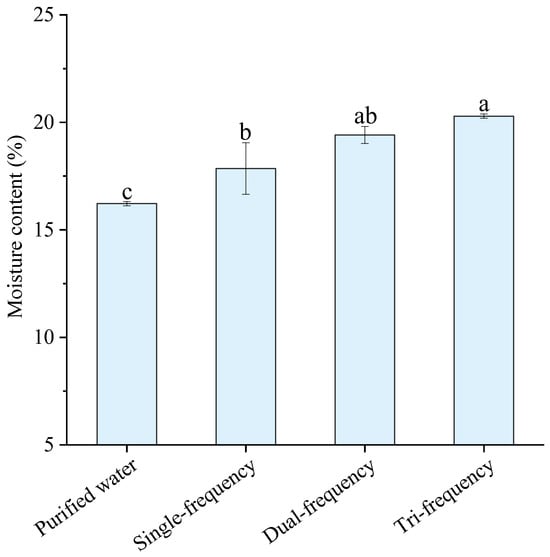
Figure 2.
Effects of different ultrasonic frequencies on moisture content in wheat grain. Note: Intergroup differences were analyzed using Duncan’s multiple range test with a significance level of α = 0.05, different lowercase letters (a, b and c) indicate statistically significant differences between groups, while shared letters denote no significant difference.
3.3.2. Weight Gain and Loss of Solids
According to the experimental data in Figure 3 and Figure 4, ultrasonic frequency significantly influenced the weight gain and solid loss rates of wheat grains. The control group (untreated) exhibited a weight gain rate of only 13% and a solid loss rate of 5.1%. In contrast, after single-frequency (22 kHz), dual-frequency (22/40 kHz), and tri-frequency (22/33/40 kHz) ultrasound treatments, the weight gain rates increased to 15.2%, 16.9%, and 18.5%, respectively, while solid loss rates concurrently rose to 5.2%, 5.4%, and 5.5%. These frequency-dependent variations suggest a positive correlation between ultrasound energy input intensity and physical damage to the surface and interfacial structures of wheat grains.
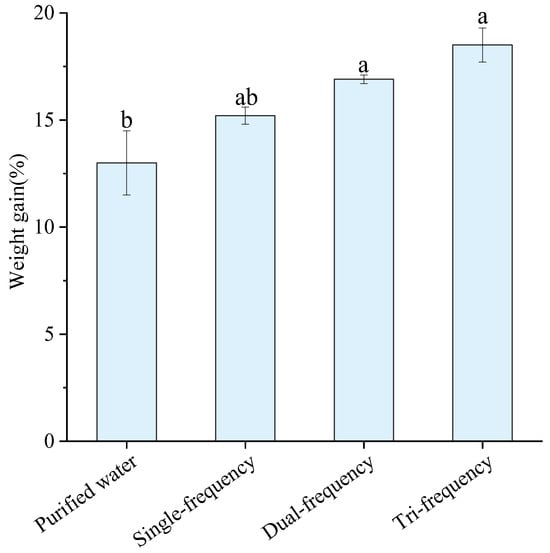
Figure 3.
Effects of different ultrasonic frequencies on grain weight gain in wheat. Note: Intergroup differences were analyzed using Duncan’s multiple range test with a significance level of α = 0.05, different lowercase letters (a and b) indicate statistically significant differences between groups, while shared letters denote no significant difference.
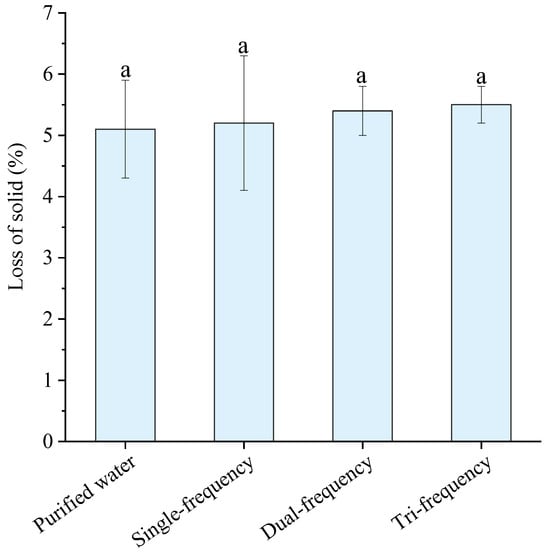
Figure 4.
Effects of different ultrasonic frequencies on solid loss in wheat grain. Note: Intergroup differences were analyzed using Duncan’s multiple range test with a significance level of α = 0.05, while shared letters “a” denote no significant difference.
From a mechanistic perspective, ultrasound-induced cavitation is the primary driver of these phenomena. On one hand, microjets generated during cavitation bubble collapse penetrate the waxy layer of the grain surface, disrupting its hydrophobic barrier and enabling rapid water infiltration into the endosperm through newly formed micropores, thereby significantly enhancing weight gain []. On the other hand, high-frequency vibrations induce fatigue fracture of aleurone layer cells (rich in proteins and ash) attached to the grain surface, causing solid components, such as starch granules, soluble proteins, and micronutrients, to detach from damaged tissues. These solids are subsequently retained by filter paper, manifesting as mass loss [].
3.3.3. Colorimetry
As shown in Table 3, ultrasound treatment exerted a partially significant effect on the color of wheat grains. Fresh wheat grains exhibited the highest lightness (L* = 56.32), while the water-treated group showed a significant decrease in L* (52.84, a 6.18% reduction), indicating that water immersion alone reduced surface reflectivity, likely due to starch granule swelling or disruption of the waxy layer caused by water penetration []. The ultrasound-treated groups (single-frequency: L* = 54.27; dual-frequency: L* = 54.69; tri-frequency: L* = 54.36) exhibited higher lightness than the water-treated group but remained lower than fresh wheat. Among them, the dual-frequency group achieved the highest L*, suggesting milder structural damage to the grain surface, possibly due to optimized water distribution via synergistic cavitation effects, thereby reducing light scattering losses.

Table 3.
Effects of different frequency treatment conditions on grain color and luster of wheat.
As shown in Table 4, ultrasound treatment also exerted partial significant effects on the color of wheat flour. The L* (lightness) and b* (yellow–blue axis) values generally decreased with increasing ultrasonic frequency, while a* (red–green axis) showed no significant differences. This indicates that ultrasound treatment reduced the brightness of wheat flour and shifted its color toward a whiter hue. However, the color difference (∆E) exhibited no statistically significant variations post-treatment, suggesting that ultrasound had minimal overall impact on the color characteristics of wheat flour.

Table 4.
Effects of different frequency treatment conditions on the color of wheat flour.
3.3.4. Hardness
As shown in Figure 5, the hardness of fresh wheat grains was the highest, while treated grains exhibited lower hardness compared to the untreated group. Ultrasound-treated grains showed even lower hardness than those subjected to water immersion alone, indicating a general downward trend, albeit with modest reductions and no statistically significant differences. The combined effects of water immersion and ultrasound treatment facilitated moisture penetration into the grains, softening their texture and progressively reducing hardness. These results demonstrate that ultrasound treatment reduces wheat hardness, with higher ultrasonic frequencies correlating to greater reductions. Specifically, the hardness values were 9915 g for untreated grains, 8795 g for water-immersed grains (25 °C, 30 min), and further decreased to 8695 g, 8400 g, and 8010 g for the single-frequency (22 kHz), dual-frequency (22/44 kHz), and tri-frequency (22/33/40 kHz) ultrasound-treated groups, respectively.
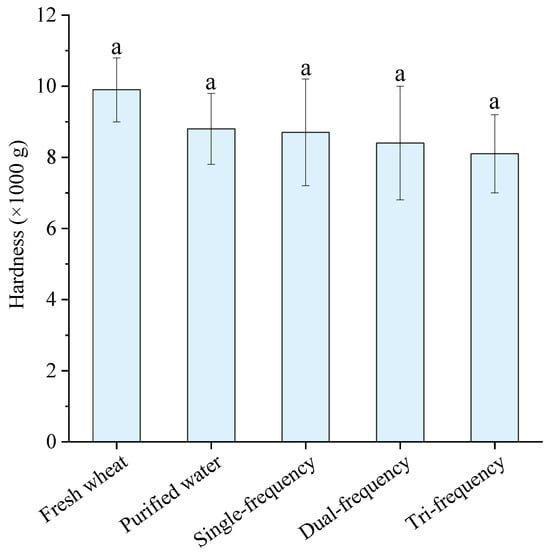
Figure 5.
Effect of different ultrasonic frequencies on grain hardness of wheat. Note: Intergroup differences were analyzed using Duncan’s multiple range test with a significance level of α = 0.05, while shared letters “a” denote no significant difference.
Mechanistically, the decline in hardness primarily stems from the synergistic effects of water immersion and ultrasound. Microjets generated by collapsing cavitation bubbles penetrate the waxy epidermal layer of the grains, creating micropores (0.5–1.2 μm in diameter) on the surface. These pores allow rapid water infiltration into the endosperm, where moisture interacts with the starch–protein matrix, weakening hydrogen bond networks and ultimately reducing macroscopic hardness [].
3.3.5. Viscosity
As shown in Figure 6, wheat flour milled from grains soaked in pure water without ultrasound treatment exhibited the highest viscosity. However, viscosity decreased after applying different ultrasonic frequencies, though it did not reach the level of the untreated control group, and no significant differences were observed among the ultrasound-treated groups. The viscosity of the wheat flour extract is associated with polysaccharides, particularly pentosans, which are the primary viscous components. The observed viscosity increase may be attributed to ultrasound treatment altering pentosan content, thereby elevating viscosity [].
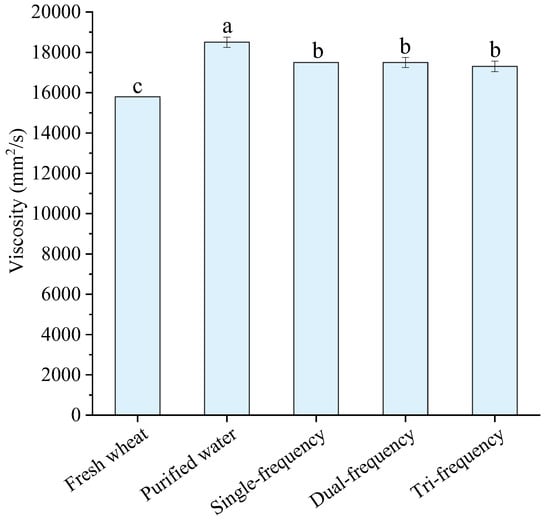
Figure 6.
Effect of different ultrasonic frequencies on viscosity of wheat. Note: Intergroup differences were analyzed using Duncan’s multiple range test with a significance level of α = 0.05, different lowercase letters (a and b) indicate statistically significant differences between groups, while shared letters denote no significant difference.
4. Conclusions
This study systematically evaluated the decontamination effects of ultrasound technologies with different frequencies on deoxynivalenol (DON) in wheat. The experimental results demonstrated that dual-frequency ultrasound (22/40 kHz) achieved a 25.84% DON removal rate after 40 min treatment, significantly outperforming single-frequency (22.29%) and triple-frequency (21.68%) ultrasound. This efficiency enhancement originates from the synergistic cavitation effects between high-low frequency sound fields, which expand cavitation coverage and intensify free radical generation. Compared with conventional methods, ultrasound technology exhibits notable competitiveness: While thermal treatment can reduce DON content by elevating temperature, excessive heat severely damages wheat nutritional structure, while lower temperatures result in significantly inferior degradation rates compared to ultrasound elution. Chemical methods improve efficiency but risk introducing pollutant residues, whereas ultrasound requires no chemical reagents, aligning with green processing requirements. Although biodegradation methods (e.g., microbial/enzymatic degradation) enable efficient decomposition, they face bottlenecks including complex strain screening, environmental sensitivity, and high costs. In contrast, ultrasound technology offers operational simplicity and strong stability, making it more suitable for industrial applications. While ultrasound’s impact on wheat quality remains controllable (minor changes in color and viscosity), the increased moisture content and reduced hardness require process optimization. The core advantages of ultrasound technology lie in its balanced environmental friendliness, operational safety, and moderate removal efficiency, particularly suitable for chemical-sensitive front-end food processing. Future research should focus on optimizing ultrasound parameters (e.g., acoustic intensity, duty cycle) for enhanced efficiency, exploring synergistic effects with photocatalysis/nanomaterials, while compensating physical property changes through tempering or drying processes. These advancements will facilitate laboratory-to-industrial translation, providing more universal solutions for safe grain processing.
Author Contributions
B.W.—conceptualization, funding acquisition, supervision; C.S.—investigation, writing—original draft; S.N.—writing; B.S.—investigation; H.M.—supervision; project administration. Y.G.—methodology, writing—review and editing. All authors have read and agreed to the published version of the manuscript.
Funding
This research was funded by the National Key Research and Development Program (No. 2022YFE0133600-02) and the Taizhou Science and Technology Support Plan (Agriculture) Project (No. TN202321).
Institutional Review Board Statement
Not applicable.
Data Availability Statement
Data are contained within the article. The original contributions presented in this study are included in the article. Further inquiries can be directed to the corresponding author.
Conflicts of Interest
The authors declare no conflicts of interest.
References
- Wu, J.; Manning, P.; Stasiewicz, M.J. Distillation as an alternative use for DON-contaminated wheat or rye: Minimal carryover of DON into distilled spirits. Food Addit. Contam. Part A 2025, 42, 369–375. [Google Scholar] [CrossRef] [PubMed]
- Soumya Moonjely, M.E.; Paton-Glassbrook, D.; Noel, Z.A.; Roze, L.; Shay, R.; Watkins, T.; Trail, F. Update on the state of research to manage Fusarium head blight. Fungal Genet. Biol. 2023, 169, 103829. [Google Scholar] [CrossRef]
- Chiha, M.; Hamdaoui, O.; Baup, S.; Gondrexon, N. Sonolytic degradation of endocrine disrupting chemical 4-cumylphenol in water. Ultrason. Sonochem. 2011, 18, 943–950. [Google Scholar] [CrossRef] [PubMed]
- Zúñiga-Benítez, H.; Soltan, J.; Peñuela, G.A. Application of ultrasound for degradation of benzophenone-3 in aqueous solutions. Int. J. Environ. Sci. Technol. 2016, 13, 77–86. [Google Scholar] [CrossRef]
- Marin, S.; Ramos, A.J.; Cano-Sancho, G.; Sanchis, V. Mycotoxins: Occurrence, toxicology, and exposure assessment. Food Chem. Toxicol. 2013, 60, 218–237. [Google Scholar] [CrossRef] [PubMed]
- de Lima Rocha, D.F.; Oliveira, M.D.S.; Furlong, E.B.; Junges, A.; Paroul, N.; Valduga, E.; Backes, G.T.; Zeni, J.; Cansian, R.L. Evaluation of the TLC quantification method and occurrence of deoxynivalenol in wheat flour of southern Brazil. Food Addit. Contam. Part A 2017, 34, 2220–2229. [Google Scholar] [CrossRef]
- Tabuc, C.; Marin, D.; Guerre, P.; Sesan, T.; Bailly, J.D. Molds and Mycotoxin Content of Cereals in Southeastern Romania. J. Food Prot. 2009, 72, 662–665. [Google Scholar] [CrossRef]
- Ji, F.; Xu, J.; Liu, X.; Yin, X.; Shi, J. Natural occurrence of deoxynivalenol and zearalenone in wheat from Jiangsu province, China. Food Chem. 2014, 157, 393–397. [Google Scholar] [CrossRef]
- Mishra, S.; Srivastava, S.; Dewangan, J.; Divakar, A.; Rath, S.K. Global occurrence of deoxynivalenol in food commodities and exposure risk assessment in humans in the last decade: A survey. Crit. Rev. Food Sci. Nutr. 2020, 60, 1346–1374. [Google Scholar] [CrossRef]
- Feizollahi, E.; Roopesh, M.S. Mechanisms of Deoxynivalenol (DON) degradation during different treatments: A review. Crit. Rev. Food Sci. Nutr. 2022, 62, 5903–5924. [Google Scholar] [CrossRef]
- Li, M.; Guan, E.; Bian, K. Effects of 60Co-γ irradiation on degradation of DON in scabbed wheat. J. Chin. Cereals Oils Assoc. 2015, 10, 1–5+14. [Google Scholar]
- Liu, Y.; Li, M.; Bian, K.; Guan, E.; Liu, Y.; Lu, Y. Reduction of Deoxynivalenol in Wheat with Superheated Steam and Its Effects on Wheat Quality. Toxins 2019, 11, 414. [Google Scholar] [CrossRef]
- Chen, X.; Qiu, Y.; Zhang, J.; Guo, Y.; Ding, Y.; Lyu, F. Degradation efficiency and products of deoxynivalenol treated by cold plasma and its application in wheat. Food Control 2022, 136, 108874. [Google Scholar] [CrossRef]
- Zhang, Y.; Ouyang, B.; Zhang, W.; Guang, C.; Xu, W.; Mu, W. Deoxynivalenol: Occurrence, toxicity, and degradation. Food Control 2024, 155, 110027. [Google Scholar] [CrossRef]
- Long, Y.; Mengmeng, L.; Guan, E.; Bian, K. Study on the degradation effect of ozonated water on DON in erythrosemic wheat. J. Henan Univ. Technol. (Nat. Sci. Ed.) 2018, 25–29, 36. [Google Scholar] [CrossRef]
- Xie, M.; Wang, M. Chemical removal of DON (Disease Onychomycotoxin). Shanghai J. Agric. 2000, 1, 58–61. [Google Scholar]
- Wu, Q.; Lohrey, L.; Cramer, B.; Yuan, Z.; Humpf, H. Impact of physicochernical parameters on the decomposition of deoxynivalenol during extrusion cooking of wheat grits. J. Agric. Food Chem. 2011, 59, 12480–12485. [Google Scholar] [CrossRef]
- He, Y.; Wu, L.; Liu, X.; Jiang, P.; Yu, L.; Qiu, J.; Ma, H. TaUGT6, a novel UDP-Glycosyltransferase gene enhances the resistance to FHB and DON accumulation in wheat. Front. Plant Sci. 2020, 11, 574775. [Google Scholar] [CrossRef]
- Chemat, F.; Zill-e-Huma; Khan, M.K. Applications of ultrasound in food technology: Processing, preservation and extraction. Ultrason. Sonochem. 2011, 18, 813–835. [Google Scholar] [CrossRef]
- Arzeni, C.; Martínez, K.; Zema, P.; Arias, A.; Pérez, O.E.; Pilosof, A.M.R. Comparative study of high intensity ultrasound effects on food proteins functionality. J. Food Eng. 2012, 108, 463–472. [Google Scholar] [CrossRef]
- Mahmoud, M.; Alelyani, M.; Ahmed, A.M.; Fagiry, M.A.; Alonazi, B.; Abdelbasset, W.K.; Alhailiy, A.B. Ultrasonic technology as a non-thermal approach for processing of fruit and vegetable juices: A review. Int. J. Food Prop. 2023, 26, 1114–1121. [Google Scholar] [CrossRef]
- Abdurahman, M.H.; Abdullah, A.Z.; Shoparwe, N.F. A comprehensive review on sonocatalytic, photocatalytic, and sonophotocatalytic processes for the degradation of antibiotics in water: Synergistic mechanism and degradation pathway. Chem. Eng. J. 2021, 413, 127412. [Google Scholar] [CrossRef]
- Fan, Q.; Zhang, J.; Cao, R.; Dai, C.; Wang, X.; Zhou, L. Ultrasonic-catalyzed ozone degradation of dibutyl phthalate in camel’s milk: Efficiency and oxidation profile. Environ. Technol. Innov. 2025, 37, 104035. [Google Scholar] [CrossRef]
- Guo, Y.; Wu, B.; Guo, X.; Liu, D.; Wu, P.; Ma, H.; Pan, Z.J. Ultrasonication and thermosonication blanching treatments of carrot at varying frequencies: Effects on peroxidase inactivation mechanisms and quality characterization evaluation. Food Chem. 2021, 343, 128524. [Google Scholar] [CrossRef] [PubMed]
- GB/T 5516-2011; Determination of Grain Oil—Determination of Kinematic Viscosity of Grains—Capillary Viscometer Method. Standards Press of China: Beijing, China, 2011.
- Yuan, D.; Li, Y. Ultrasonic modification to improve solubility of soybean isolate protein under acidic conditions. Food Feed. Ind. 2008, 1, 27–29. [Google Scholar] [CrossRef]
- Malik, S.; Saroha, A.K. Removal of Phenol from Wastewater Using Ultrasound Cavitation. J. Hazard. Toxic Radioact. Waste 2025, 29, 04024042. [Google Scholar] [CrossRef]
- Tiong, T.J.; Liew, D.K.L.; Gondipon, R.C.; Wong, R.W.; Loo, Y.L.; Lok, M.S.T.; Manickam, S. Identification of active sonochemical zones in a triple frequency ultrasonic reactor via physical and chemical characterization techniques. Ultrason. Sonochem. 2017, 35, 569–576. [Google Scholar] [CrossRef]
- Song, X. Numerical Calculation of Stepped Disc Nodal Line Position and Sound Field Distribution. Master’s Thesis, Shaanxi Normal University, Xi’an, China, 2009. [Google Scholar]
- Bullerman, L.B.; Bianchini, A. Stability of mycotoxins during food processing. Int. J. Food Microbiol. 2007, 119, 140–146. [Google Scholar] [CrossRef]
- Stepanik, T.; Kost, D.; Nowicki, T.; Gabay, D. Effects of electron beam irradiation on deoxynivalenol levels in distillers dried grain and solubles and in production intermediates. Food Addit. Contam. 2007, 24, 1001–1006. [Google Scholar] [CrossRef]
- Wang, J.; Vanga, S.K.; Raghavan, V. High-intensity ultrasound processing of kiwifruit juice: Effects on the ascorbic acid, total phenolics, flavonoids and antioxidant capacity. Food Sci. Technol. 2019, 107, 299–307. [Google Scholar] [CrossRef]
- Şayan, E.; Çalışkan, B. The Use of Ultrasound in Hydrometallurgical Studies: A Review on the Comparison of Ultrasound-Assisted and Conventional Leaching. J. Sustain. Metall. 2024, 10, 1933–1958. [Google Scholar] [CrossRef]
- Shevkani, K.; Singh, N.; Bajaj, R.; Kaur, A. Wheat starch production, structure, functionality and applications—A review. Int. J. Food Sci. Technol. 2017, 52, 38–58. [Google Scholar] [CrossRef]
- Kang, Z.; Geng, N.; He, M.; Xu, G.; Wang, Z.; Zhang, K. Effects of Amomum villosum polysaccharide on physicochemical and in vitro digestibility properties of wheat starch. Food Mach. 2024, 40, 19–24+110. [Google Scholar] [CrossRef]
Disclaimer/Publisher’s Note: The statements, opinions and data contained in all publications are solely those of the individual author(s) and contributor(s) and not of MDPI and/or the editor(s). MDPI and/or the editor(s) disclaim responsibility for any injury to people or property resulting from any ideas, methods, instructions or products referred to in the content. |
© 2025 by the authors. Licensee MDPI, Basel, Switzerland. This article is an open access article distributed under the terms and conditions of the Creative Commons Attribution (CC BY) license (https://creativecommons.org/licenses/by/4.0/).